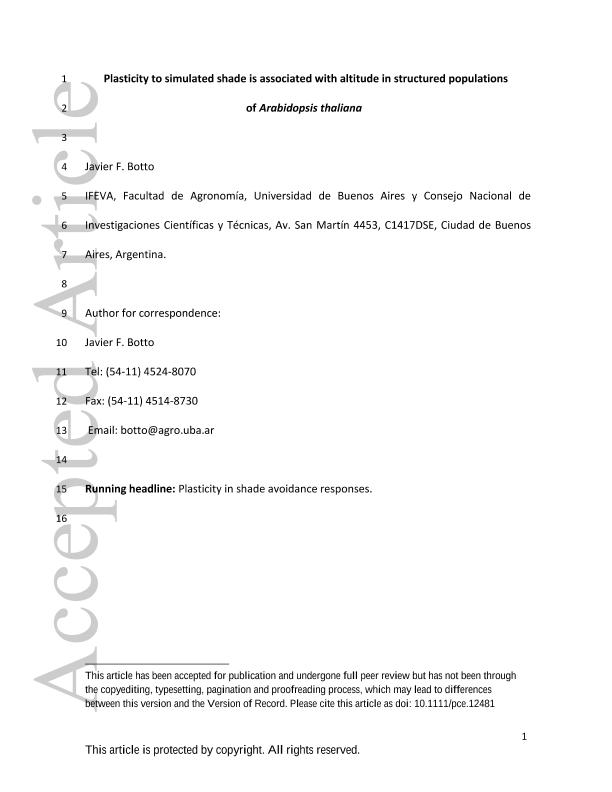Mostrar el registro sencillo del ítem
dc.contributor.author
Botto, Javier Francisco

dc.date.available
2016-02-17T20:56:17Z
dc.date.issued
2015-02-14
dc.identifier.citation
Botto, Javier Francisco; Plasticity to simulated shade is associated with altitude in structured populations of Arabidopsis thaliana; Wiley Blackwell Publishing, Inc; Plant, Cell and Environment; 38; 7; 14-2-2015; 1321-1332
dc.identifier.issn
0140-7791
dc.identifier.uri
http://hdl.handle.net/11336/4248
dc.description.abstract
Plants compete for photosynthesis light and induce a shade avoidance syndrome (SAS) that confers an important advantage in asymmetric competition for light at high canopy densities. Shade plasticity was studied in a greenhouse experiment cultivating Arabidopsis thaliana plants from 15 populations spread across an altitudinal gradient in the northeast area of Spain that contain a high genetic variation into a reduced geographical range. Plants were exposed to sunlight or simulated shade to identify the range of shade plasticity. Fourteen vegetative, flowering and reproductive traits were measured throughout the life cycle. Shade plasticity in flowering time and dry mass was significantly associated with the altitude of population origin. Plants from coastal populations showed higher shade plasticity indexes than those from mountains. The altitudinal variation in flowering leaf plasticity adjusted negatively with average and minimum temperatures, whereas dry mass plasticity was better explained by negative regressions with the average, maximum and minimum temperatures, and by a positive regression with average precipitation of the population origin. The lack of an altitudinal gradient for the widest number of traits suggests that shade light could be a driver explaining the distribution pattern of individuals in smaller geographical scales than those explored here.
dc.format
application/pdf
dc.language.iso
eng
dc.publisher
Wiley Blackwell Publishing, Inc

dc.rights
info:eu-repo/semantics/openAccess
dc.rights.uri
https://creativecommons.org/licenses/by-nc-sa/2.5/ar/
dc.subject
ALTITUDINAL GRADIENT
dc.subject
LIGHT
dc.subject
LOCAL ADAPTATION
dc.subject
PHENOTYPIC PLASTICITY
dc.subject
PHYTOCHROMES
dc.subject
SHADE AVOIDANCE SYNDROME
dc.subject.classification
Ciencias de las Plantas, Botánica

dc.subject.classification
Ciencias Biológicas

dc.subject.classification
CIENCIAS NATURALES Y EXACTAS

dc.subject.classification
Ecología

dc.subject.classification
Ciencias Biológicas

dc.subject.classification
CIENCIAS NATURALES Y EXACTAS

dc.title
Plasticity to simulated shade is associated with altitude in structured populations of Arabidopsis thaliana
dc.type
info:eu-repo/semantics/article
dc.type
info:ar-repo/semantics/artículo
dc.type
info:eu-repo/semantics/publishedVersion
dc.date.updated
2016-03-30 10:35:44.97925-03
dc.journal.volume
38
dc.journal.number
7
dc.journal.pagination
1321-1332
dc.journal.pais
Reino Unido

dc.journal.ciudad
Londres
dc.conicet.avisoEditorial
This is the peer reviewed version of the following article: Botto, Javier Francisco; Plasticity to simulated shade is associated with altitude in structured populations of Arabidopsis thaliana; Wiley; Plant, Cell and Environment; 38; 7; 14-2-2015; 1321–1332 , which has been published in final form at http://dx.doi.org/DOI:10.1111/pce.12481. This article may be used for non-commercial purposes in accordance with Wiley Terms and Conditions for Self-Archiving
dc.description.fil
Fil: Botto, Javier Francisco. Consejo Nacional de Investigaciones Científicas y Técnicas. Oficina de Coordinación Administrativa Parque Centenario. Instituto de Investigaciones Fisiológicas y Ecológicas Vinculadas a la Agricultura; Argentina
dc.journal.title
Plant, Cell and Environment

dc.relation.alternativeid
info:eu-repo/semantics/altIdentifier/url/http://onlinelibrary.wiley.com/doi/10.1111/pce.12481/abstract
dc.relation.alternativeid
info:eu-repo/semantics/altIdentifier/doi/http://dx.doi.org/DOI:10.1111/pce.12481
Archivos asociados
